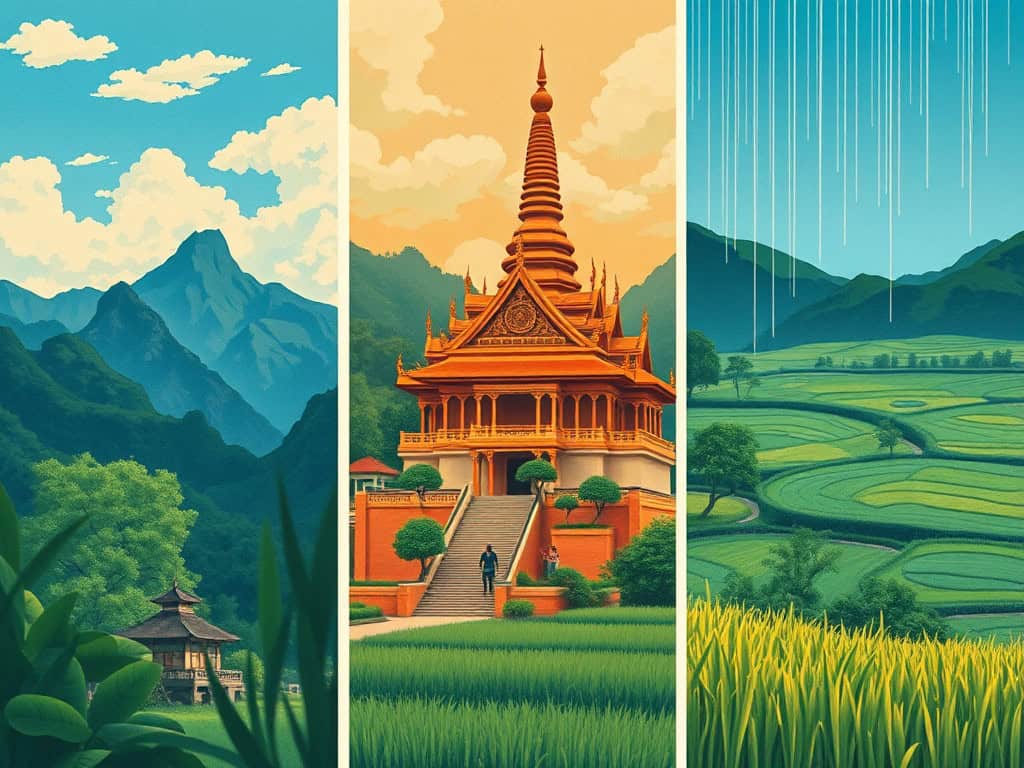If you’re wondering when the best time to visit Chiang Mai is, whether for a short trip or long-term stay, you’ve come to the right place. I’ve lived through all of Chiang Mai’s seasons – the good, the bad, and yes, the smoky – and I’m here to give you the unfiltered truth about what it’s really like throughout the year.
This comprehensive seasonal guide breaks down Chiang Mai’s weather patterns, cultural events, and tourist trends to help you plan your Chiang Mai adventure.
The Best Time to Visit Chiang Mai Quick Facts:
- When is high season in Chiang Mai?
- November to February is high season, with cooler weather and popular festivals like Loy Krathong & Yi Peng. This is the best time for tourists but also the most expensive.
- What is the best time for digital nomads to visit Chiang Mai?
- November to March offers a good balance of pleasant weather, coworking spaces buzzing with activity, and events perfect for networking.
- When is burning season in Chiang Mai?
- February & March is the worst of burning season when atmospheric conditions, crop clearing, and forest fires lead to poor air quality. Consider leaving the city or exploring the Thai islands during this time.
- What is the cheapest time to visit Chiang Mai?
- June to September (rainy season) offers lower prices on accommodation and flights, with lush greenery and fewer crowds.
- Is it worth visiting Chiang Mai during rainy season?
- Yes! June to September brings daily showers and still plenty of sunshine, but fewer tourists and greener landscapes.
- What are Chiang Mai’s Top Festivals & Event Dates in 2024 & 2025?
- Bo Sang Umbrella & Handicraft Festival: January 17-19, 2025
- Chinese New Year: January 29, 2025
- Chiang Mai Flower Festival: February 7-9, 2025
- Songkran Festival: April 13-15, 2025
- Doi Suthep Pilgrimage: May 11, 2025
- Inthakin City Pillar Festival: May 30 – June 6, 2025
- Vegetarian Festival: September 21-30, 2025
- Yi Peng & Loy Krathong: November 15-17, 2024
- Chiang Mai SEO Conference: November 18-22, 2024
- Chiang Mai Design Week: December 7-15, 2024
- TEDxChiangMai: 2025 Dates TBA
- Block Mountain: 2025 Dates TBA
Why Chiang Mai is a Popular Seasonal Destination
Chiang Mai’s got this cool thing going on – literally. Nestled in the foothills of the Himalayas, it’s Thailand’s refreshing getaway, offering variation from the intense tropical heat that dominates the rest of the country. Think sweater-weather winters and balmy summers.
If you come from a temperate climate, you’ll laugh at our notion of cold, but for domestic tourists, it’s a big deal to come up and experience this variety in temperatures.
Our seasons in brief:
- Cool season: Perfect for hitting those hiking trails or exploring outdoor attractions.
- Hot (burning) season: Intense heat and poor air quality prompts a mass exodus to the coasts. It’s like a reverse holiday season.
- Rainy season: Call it wet season or green season, the monsoon brings daily showers and explosions of tropical growth.
Chiang Mai’s events calendar is as varied as its weather. From Yi Peng lantern releases lighting up the November sky to Songkran water fights turning April into a city-wide splash party, there’s always something happening.
It’s this mix of ever-changing weather, rich culture, and outdoor adventures that keeps Chiang Mai interesting year-round.
Chiang Mai Weather: What to Expect Year Round
Chiang Mai’s tropical climate is varied throughout the year, but pretty consistent within each season. Each of our three seasons comes with its own perks and quirks.
“Cold” Season (November to February) – Cool, Pleasant, and Busy
It’s no surprise why November to February is our high season, cold season is when Chiang Mai is at its best. Temperatures hover between 15°C and 28°C (59°F to 82°F) so “cold” is speaking relatively. But it’s pretty perfect for exploring temples, hiking, or just wandering around.
For tourists, this is prime time and you’ll catch some of our best festivals. But here’s the thing – everyone knows this is the best time to visit Chiang Mai so it gets crowded. Like, really crowded. Prices go up, there’s nowhere to park, and you actually need to plan ahead to book hotels and event tickets.
If you’re a digital nomad or thinking of a longer stay, this season can be a mixed bag. On one hand, the weather is amazing, and there’s always something going on. On the other, you might find your favorite coffee shop overrun with tourists, and competition for the best condos is fierce. The networking opportunities will be awesome though – our nomadic friends always start trickling back this time of year.
Key points for the cool season:
- Best weather for sightseeing and outdoor activities
- Peak tourist season with higher prices and crowds
- Major festivals like Yi Peng and Loy Krathong
- Great networking opportunities for digital nomads
- Book accommodation well in advance, especially around Loy Krathong and New Year’s
Packing Notes: Layer up for the cool mornings and evenings. Pack a light sweaters and a long-sleeved shirt or two. During the day, t-shirts and shorts are still comfortable. Women might want to bring a light scarf or shawl, also useful for temple visits. For festivals like Yi Peng and Loy Krathong, bring something nice but comfortable – many locals wear traditional Thai clothing, so a nice sundress for women or a button-up shirt and slacks for men would be appropriate.
Hot Season (March to May) – The Sizzle, the Haze, and the Big Splash
Ah, hot season in Chiang Mai. It’s exactly what it says on the tin – hot. We’re talking temperatures that regularly hit 35°C (95°F) and sometimes creep up to 40°C (104°F). It’s the kind of heat leaves you sweating only seconds after you’ve stepped out of the shower.
This is also when the infamous burning season typically occurs, usually peaking between March and April. The air gets thick with haze from agricultural burning in the region, which can be a real challenge for those with respiratory issues or anyone who enjoys, you know, breathing.
For tourists, it’s a bit of a mixed bag. You’ll find fewer crowds and potentially lower prices on accommodations, but sightseeing can be a sweaty, smoky affair. Indoor attractions suddenly become very appealing – hello, air-conditioned shopping malls and museums!
If you’re a digital nomad or planning a longer stay, this is when you’ll see the great Chiang Mai exodus. Many long-term residents and nomads use this as an excuse for extended beach vacations or visa runs to neighboring countries. Those who stay invest heavily in air purifiers and seek out cafes and coworking spaces with “clean air” rooms.
For those concerned about the haze, we’ve got an in-depth burning season guide covering everything from health considerations to coping strategies.
But it’s not all doom and gloom. The hot season brings one of Thailand’s most exciting festivals – Songkran. This Thai New Year celebration in mid-April turns the whole city into a giant water fight, offering a fun (and refreshing) respite from the heat.
Key points for the hot season:
- Temperatures often reach 35°C (95°F) or higher
- Burning season impacts air quality
- Lower tourist numbers mean better deals on accommodation
- Air purifiers become essential for those staying in the city
- Songkran in mid-April offers a fun break from the heat
Pro Tip: If you’re planning to stay in Chiang Mai during this time, look for accommodation with good air conditioning and invest in a portable air purifier.
Packing Notes: Light, breathable fabrics are key. Think loose cotton shirts, shorts, and sundresses. Both men and women should pack a hat and sunglasses. Women might want to bring a light, long-sleeved shirt for sun protection. Don’t forget swimwear for hotel pools or water activities. For Songkran, pack quick-dry clothing and water-resistant shoes. A waterproof phone case is a must. For some reason, Hawaiian-print shirts became a thing for Songkran, but you can buy one locally.
Rainy Season (June to October) – The Local’s Favorite
Don’t let the name fool you – rainy season in Chiang Mai isn’t the constant downpour you might imagine. It’s more like nature’s daily refresh button. You’ll typically see bursts of rain in the early morning and then again in the afternoon or evening, with plenty of sunshine in between. Temperatures cool down a bit, hovering between 25°C and 32°C (77°F to 90°F), which can be a relief after the scorching hot season.
For tourists, this is low season, which means two things: fewer crowds and lower prices. You’ll get a more authentic experience of the city without throngs of visitors. Plus, the countryside around Chiang Mai transforms into a lush, green paradise. It’s seriously Instagram-worthy stuff.
Honestly, I’m on the fence writing this up. On the one hand I want to keep this incredible time of year just for us locals, but on the other hand rainy season in Chiang Mai is so gorgeous I can’t say enough good things about it.
The city takes on a cozy vibe, perfect for productive work sessions in cafes while listening to the rain outside. Rent prices drop, and you’ll find great deals on accommodation. Just be prepared for the occasional flood – it happens every few years, but it’s usually not a big deal in the city center or Nimman.
Whether you’re seeking a peaceful work environment, budget-friendly travel, or a chance to see Chiang Mai’s natural beauty in full force, don’t write off the rainy season. It might just become your favorite time to be here.
Key points for the rainy season:
- Short, often predictable rain showers, not constant downpours
- Lush, green landscapes perfect for nature lovers and photographers
- Waterfalls and forests at their most vibrant
- Fewer tourists and lower prices on accommodation and activities
- Great for budget travelers and long-term visitors
Pro Tip: the right footwear can make or break your day. Flip flops will leave your feet flapping and filthy. Leather will get ruined and sneakers can get soaked. It’s a tough time of year to plan for if you’re packing light. If you want to do like the locals do, embrace knock-off Crocs – you can buy them at any street market.
Packing Notes: Quick-dry fabrics are your friend. Bring a light, packable rain jacket or poncho. Avoid jeans or heavy cotton that takes forever to dry. Sandals or water-resistant shoes are better than sneakers. Women might want to pack a few maxi dresses – they’re comfortable in the humidity and keep your legs dry from puddle splashes. Men should pack a few pairs of lightweight, quick-dry pants. For both, bring an extra pair of shoes in case one gets soaked.
Top Annual Events and Festivals in Chiang Mai
Chiang Mai loves a good festival, and timing your visit around one of these can really make your trip special. There are also a few iconic conferences and tech events that happen annually.
Here are the big ones worth putting on your calendar:
1. Bo Sang Umbrella & Handicraft Festival (January 17-19, 2025)
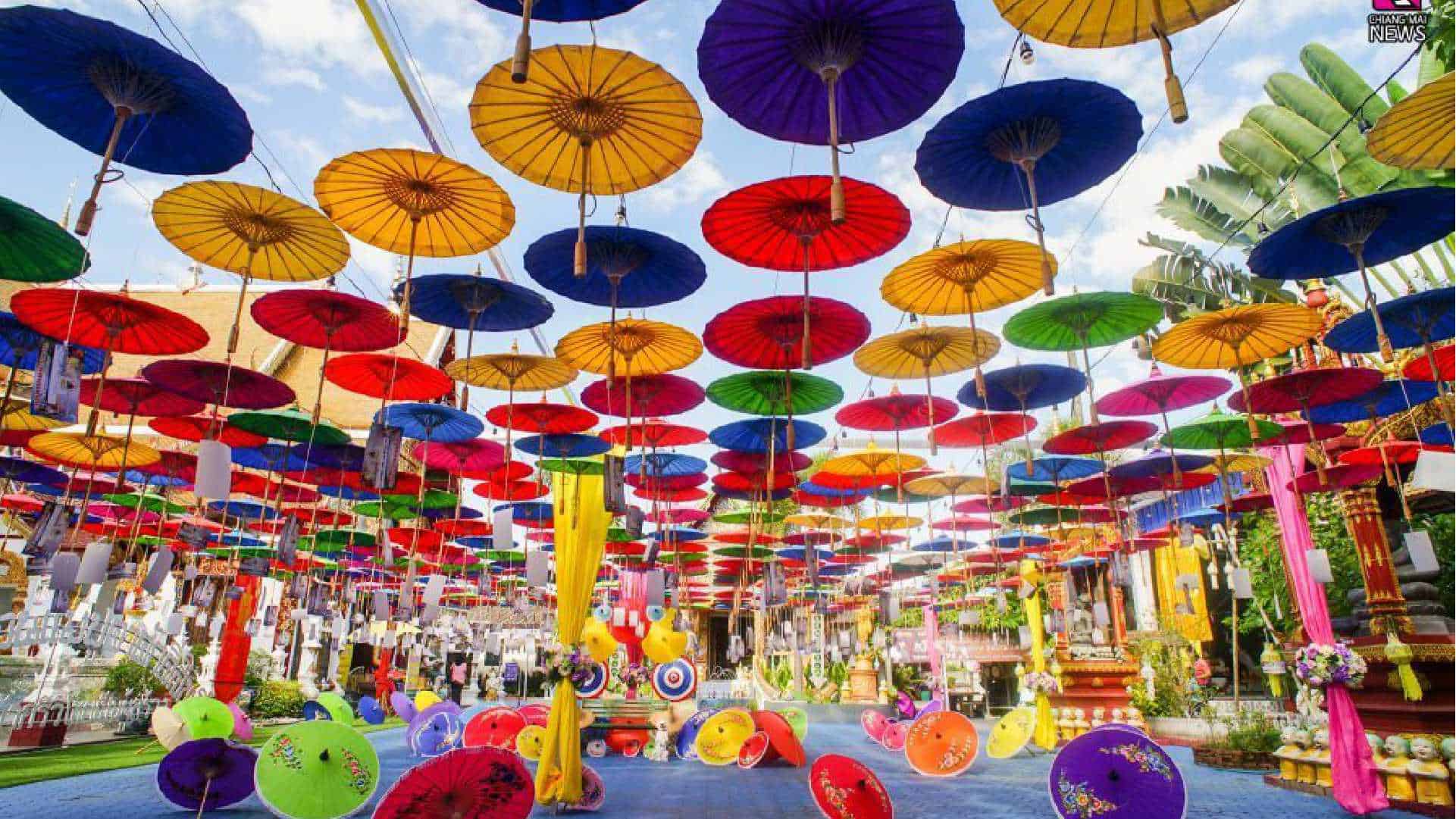
Celebrate traditional Lanna craftsmanship with vibrant umbrellas, art, and culture
The Bo Sang Umbrella Festival honors the centuries-old tradition of making hand-painted umbrellas and parasols in the quaint village of Bo Sang, a little ways out in San Khampaeng. This colorful event transforms the village with lively parades, cultural performances, and displays of intricate crafts.
Highlights:
- Where: Bo Sang Village, about 9 km east of Chiang Mai
- Weather: Cool, dry weather typical of January—great for outdoor activities
- Planning Tip: Take the time to explore the many stalls and workshops where artisans demonstrate their painting techniques
- Pro Tip: Arrive early for the morning bicycle parade and beauty pageant
- Official Site: Check with the Tourism Authority of Thailand for event updates
2. Chinese New Year in Chiang Mai (January 29, 2025)
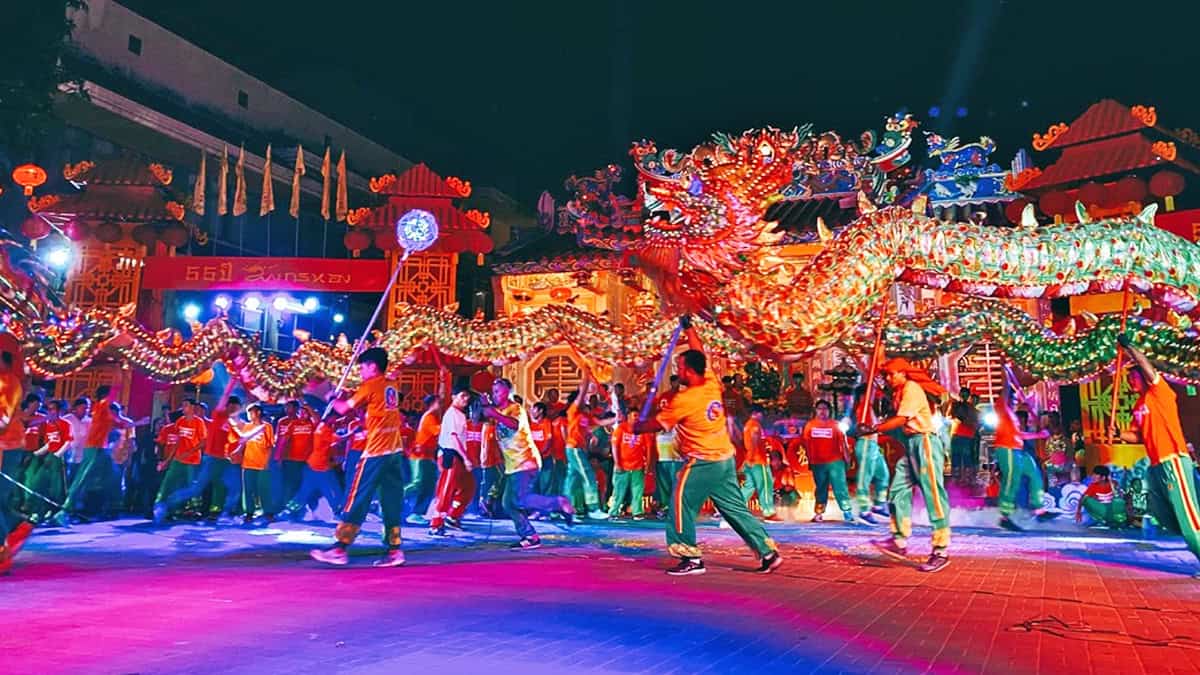
A festive celebration of culture, food, and tradition in Chiang Mai’s Chinese community
Chinese New Year is celebrated with great enthusiasm in Chiang Mai, especially within the Chinese-Thai community. While the holiday is not a national public holiday, locals and visitors flock to Warorot Market (Kad Luang) and other areas to join in the colorful festivities. The celebration includes lion and dragon dances, street performances, fireworks, and plenty of delicious street food.
Highlights:
- Where: Warorot Market (Kad Luang) and the surrounding Chinatown area
- Weather: Cool and dry in early February—perfect for street celebrations
- Planning Tip: Visit Warorot Market early to enjoy the decorations and browse Chinese delicacies
- Pro Tip: Wear red clothing to bring good luck, and try traditional foods like dumplings and sweet rice cakes
- Official Site: Check with the Tourism Authority of Thailand for event updates
3. Chiang Mai Flower Festival (February 7-9, 2025)
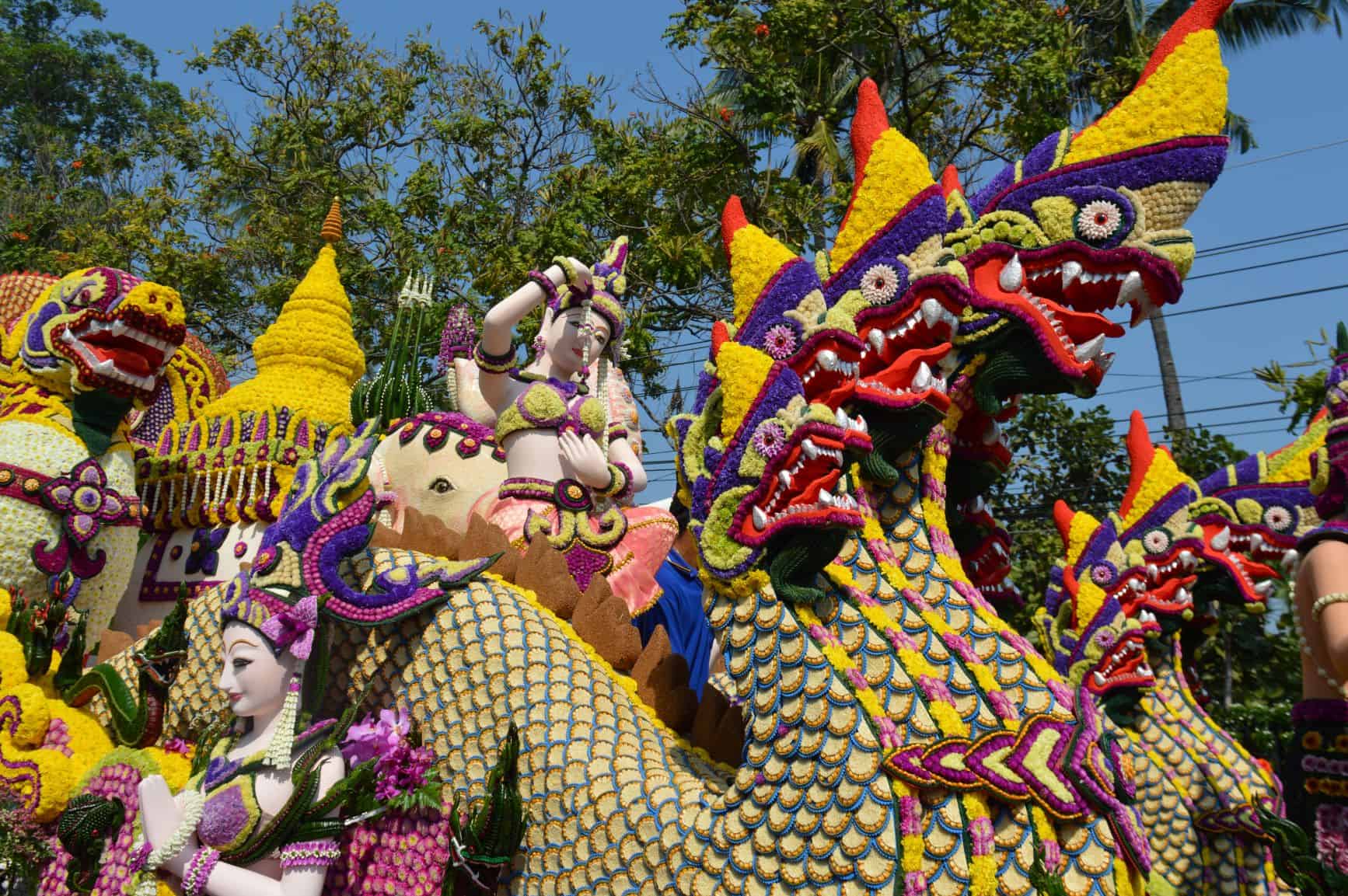
A colorful celebration of flowers and horticulture in the Old City
Held at the peak of the cool season, the Chiang Mai Flower Festival transforms the city with floral parades and garden displays. Flowers such as orchids, roses, and chrysanthemums are showcased, making this event a visual treat for nature lovers and photographers.
Highlights:
- Where: Suan Buak Haad Park and streets of the Old City
- Weather: Cool mornings and warm afternoons, ideal for outdoor activities
- Planning Tip: Staying on the opposite side of Old City, or just outside the moat means you can walk to the festivities without being engulfed in traffic every time you try to leave.
- Pro Tip: Flowers are also in bloom in the hills surrounding Chiang Mai, book a photography trip with a local guide and hit up these seasonal Instagram hotspots.
- Official Site: Tourism Authority of Thailand
4. Songkran – Thai New Year (April 13-15, 2025)
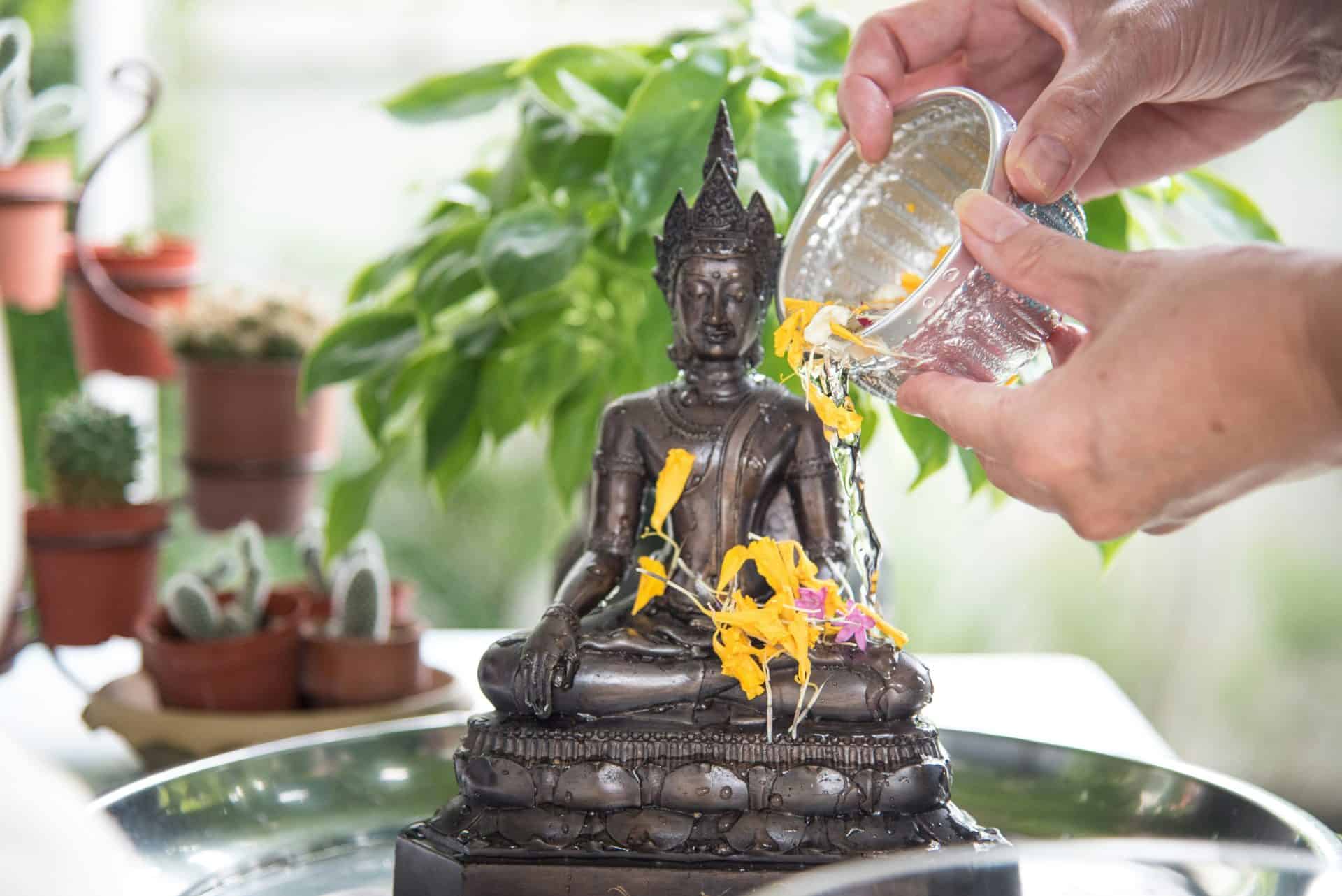
Celebrate the Thai New Year with water fights and temple ceremonies
Songkran (สงกรานต์) marks the Thai New Year, celebrated with playful water fights to wash away the past year’s misfortunes. Chiang Mai is the the best place in Thailand to experience this festival, with much of the city becoming a splash zone for locals and tourists alike.
Highlights:
- Where: Tha Phae Gate, Huay Kaew Road, and throughout the Old City
- Weather: Hottest time of the year, with temperatures often above 35°C (95°F)
- Planning Tip: Bring waterproof gear to protect phones and belongings
- Pro Tip: Balance the fun with visits to temples for traditional ceremonies
- Official Site: Tourism Authority of Thailand
5. Doi Suthep Pilgrimage (May 11, 2025)
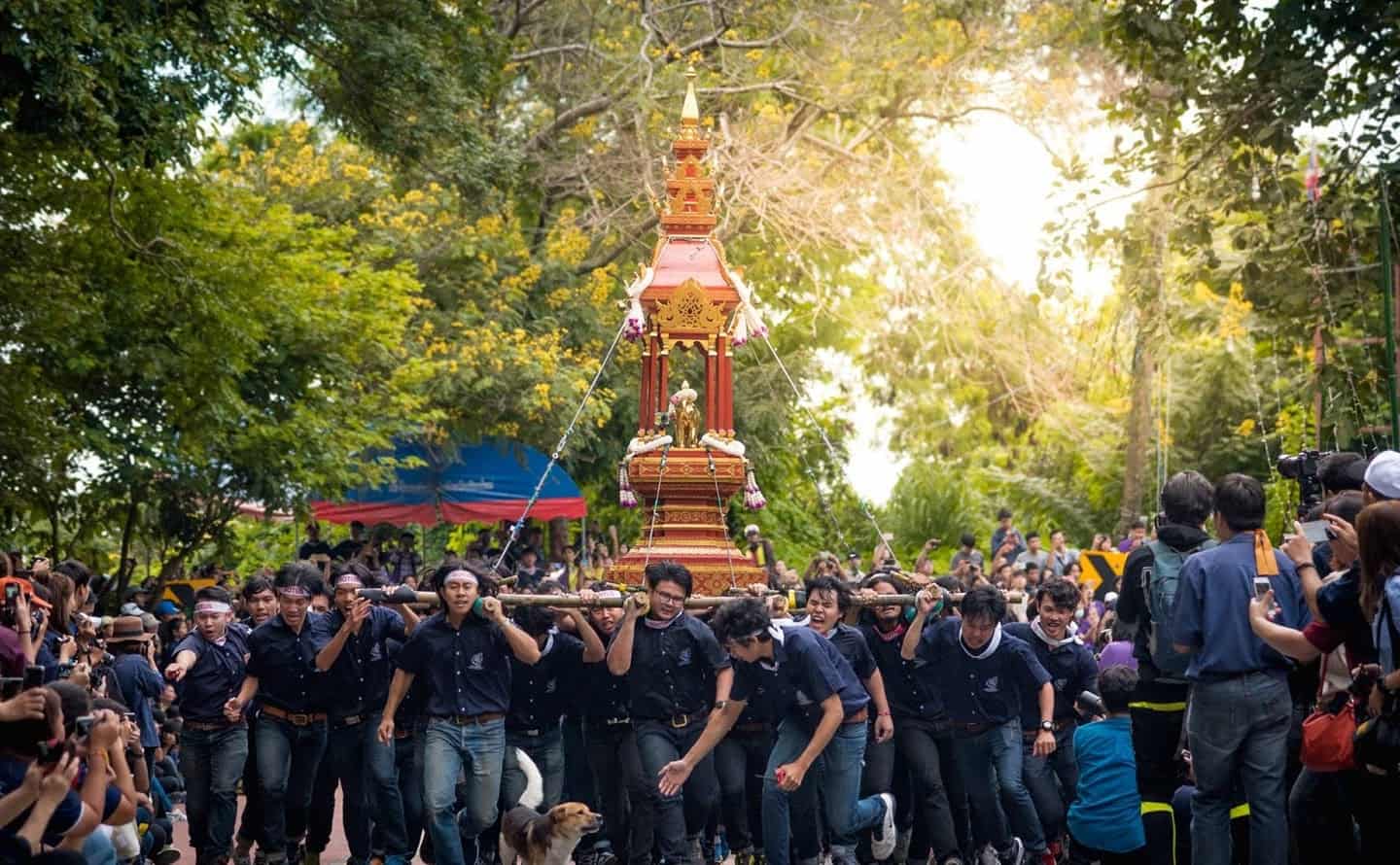
Spiritual journey to the summit of Doi Suthep to honor a sacred Buddhist relic
The annual Doi Suthep Pilgrimage is a significant religious event where thousands of locals and visitors hike up the 10-kilometer road leading to Wat Phra That Doi Suthep—one of Thailand’s most revered temples. Known colloquially as “แห่ขึ้นดอย” (hae khuen doi), The pilgrimage is both a spiritual and cultural experience. Participants walk by candlelight, praying and chanting as they ascend the mountain.
Highlights:
- Where: Pilgrimage route starts at Chiang Mai University, ending at Wat Phra That Doi Suthep
- Weather: May marks the beginning of the rainy season; bring rain gear and comfortable shoes
- Planning Tip: Join the walk in the early evening to experience the candle-lit atmosphere
- Pro Tip: Stay at the top for sunrise and enjoy panoramic views of Chiang Mai
- Official Site: Check with Tourism Authority of Thailand or temple announcements for updates
6. Inthakin City Pillar Festival (May 30-June 6, 2025)
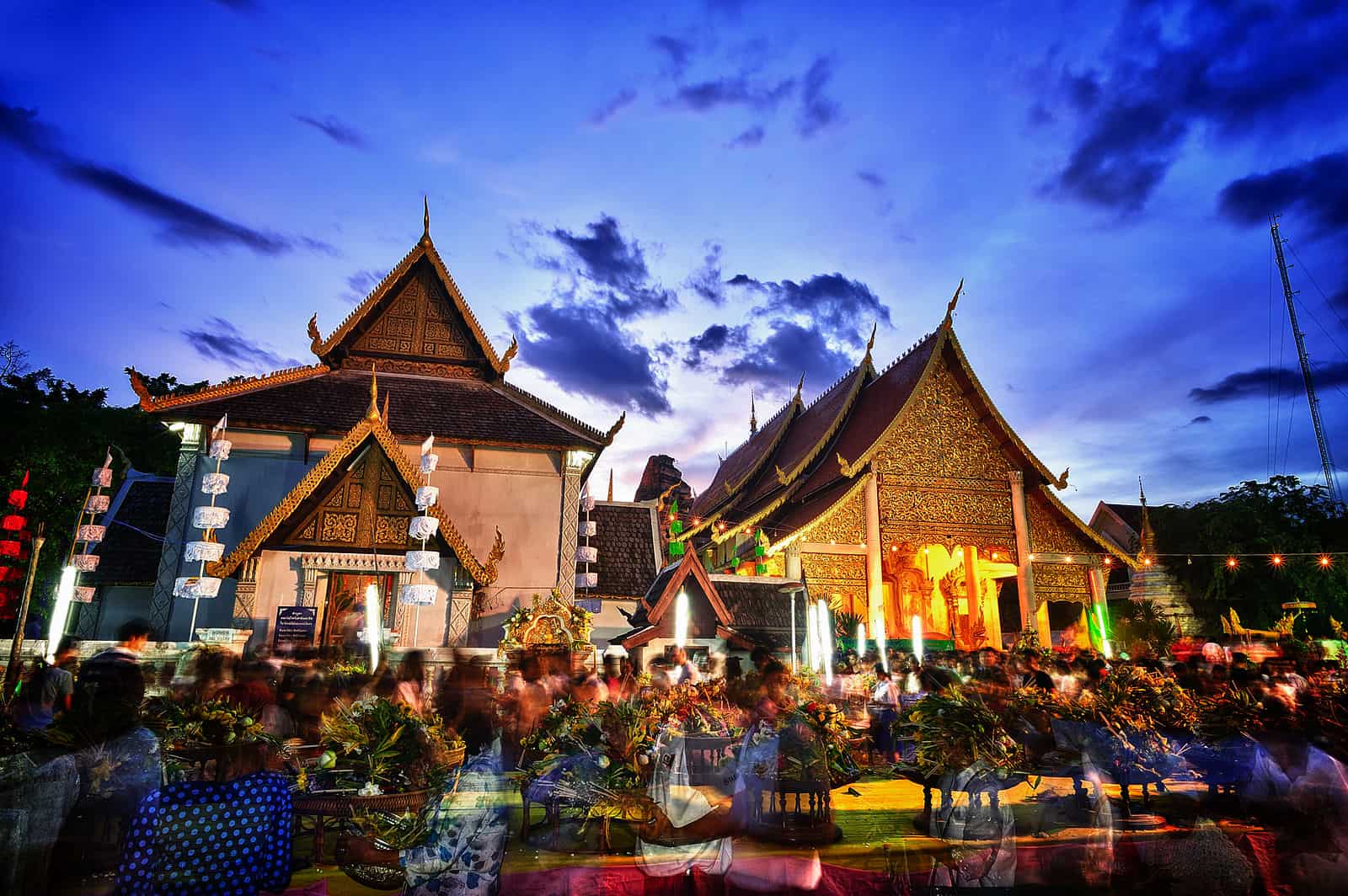
A spiritual celebration rooted in Lanna culture
Inthakin (พิธีบูชาเสาหลักเมือง) honors the city’s protective spirit through rituals and offerings at Wat Chedi Luang. This ancient festival, which reflects Chiang Mai’s deep-rooted cultural heritage, plays a significant role in maintaining the city’s prosperity and well-being.
Highlights:
- Where: Wat Chedi Luang in the Old City
- Weather: Warm with occasional afternoon showers as the rainy season begins
- Planning Tip: Visit early to avoid crowds at the temple
- Pro Tip: Respect local customs and dress modestly when attending ceremonies
- Official Site: Tourism Authority of Thailand
7. Vegetarian Festival (September 21-30, 2025)
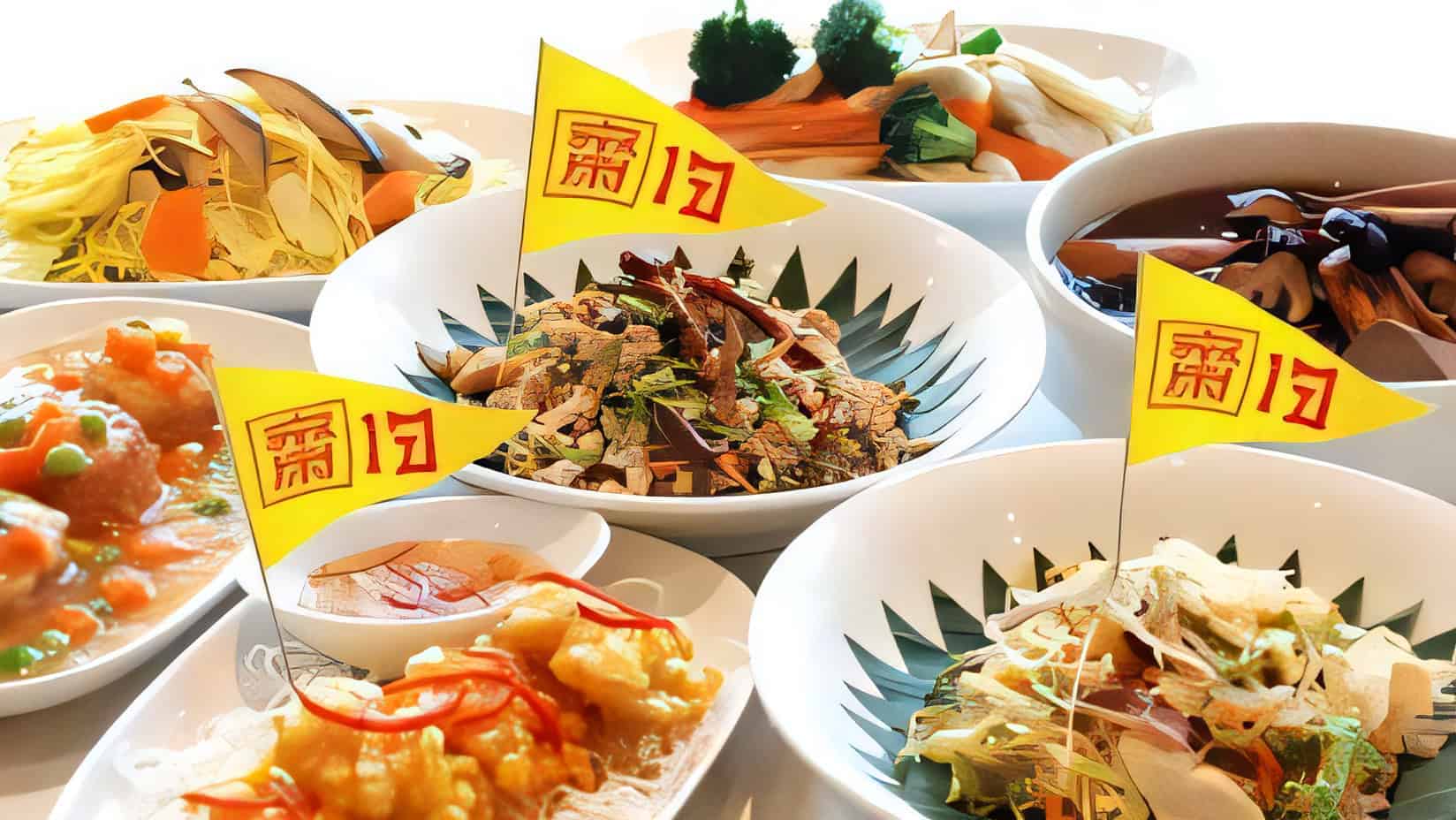
Ten days of spiritual cleansing through plant-based diets and religious rituals
Known locally as Tesagan Gin Jay (เทศกาลกินเจ), the Vegetarian Festival is an annual event centered on abstaining from meat and animal products. Though it is celebrated most prominently in Phuket, Chiang Mai also embraces this festival with vegan food stalls popping up across the city. The event promotes physical and spiritual cleansing, with locals participating in temple ceremonies and wearing white to signify purity.
Highlights:
- Where: Warorot Market, various temples, and vegan food stalls around Chiang Mai
- Weather: September sees frequent rains; indoor dining may be more comfortable
- Planning Tip: Look for yellow signs with the word “เจ” (Jay) indicating vegan-friendly food stalls
- Pro Tip: Take this opportunity to explore Chiang Mai’s vegan restaurant scene, which flourishes during the festival
- Official Site: Tourism Authority of Thailand
8. Yi Peng & Loy Krathong (November 15-17, 2024)
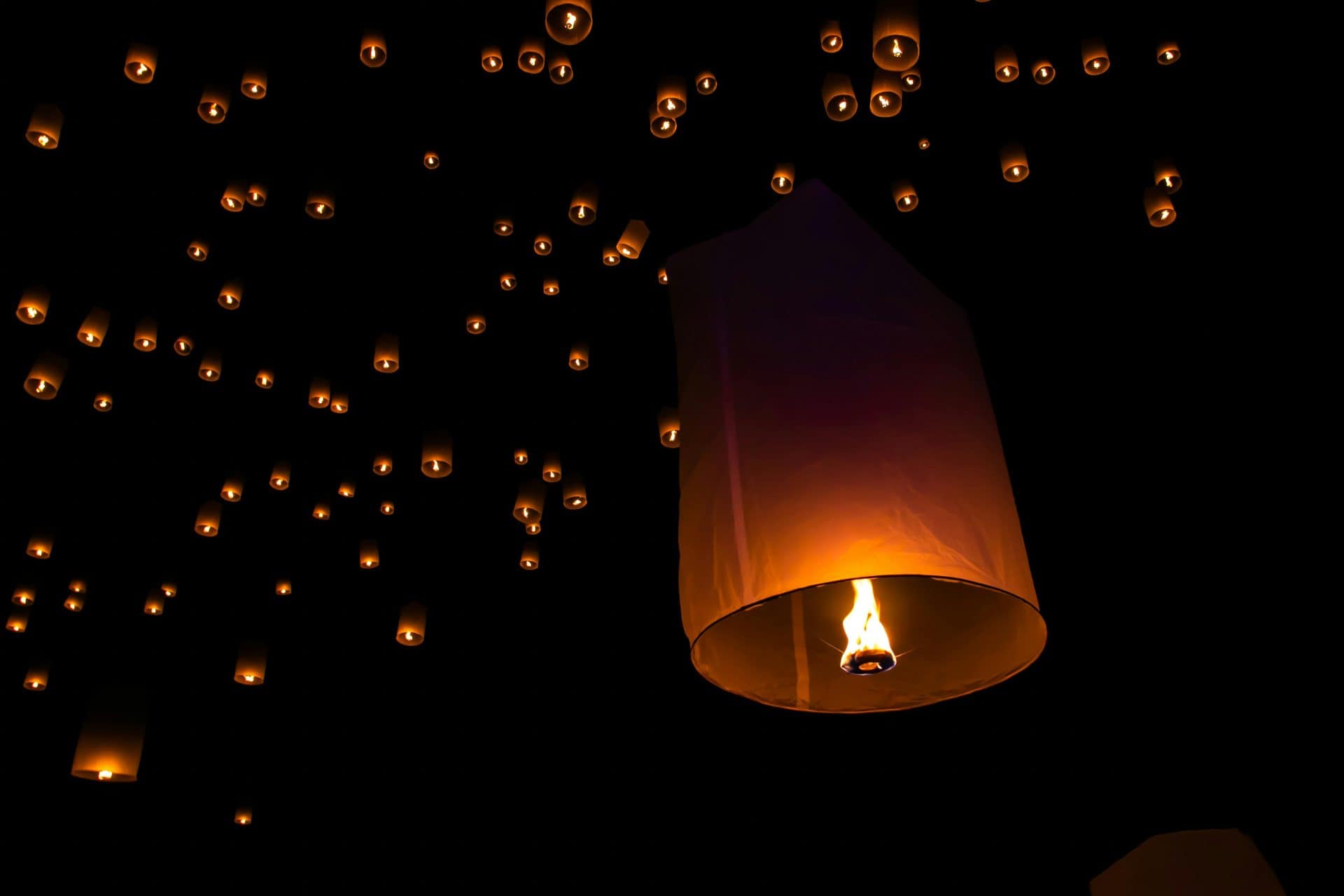
Magical sky lanterns and floating krathongs during Thailand’s Festival of Lights
This festival is one of Chiang Mai’s most iconic celebrations. Yi Peng (ยี่เป็ง) features thousands of lanterns released into the sky, symbolizing new beginnings, while Loy Krathong (ลอยกระทง) involves floating candles on water to honor the river goddess. The city transforms into a glowing spectacle, drawing visitors from all over the world.
Highlights:
- Where: The major lantern releases are near Mae Jo University (ticketed), towards Saemong (ticketed), and in Doi Saket (free); krathongs are floated all along the Ping River, but festivities will take place all across the Old City too.
- Weather: Dry, cool evenings perfect for outdoor events
- Planning Tip: Book hotels and flights well in advance as the city becomes crowded
- Pro Tip: DO NOT RELEASE LANTERNS IN THE CITY, even if you see other people doing it. They’re a fire hazard.
- Official Site: Tourism Authority of Thailand
9. Chiang Mai SEO Conference (November 18-22, 2024)
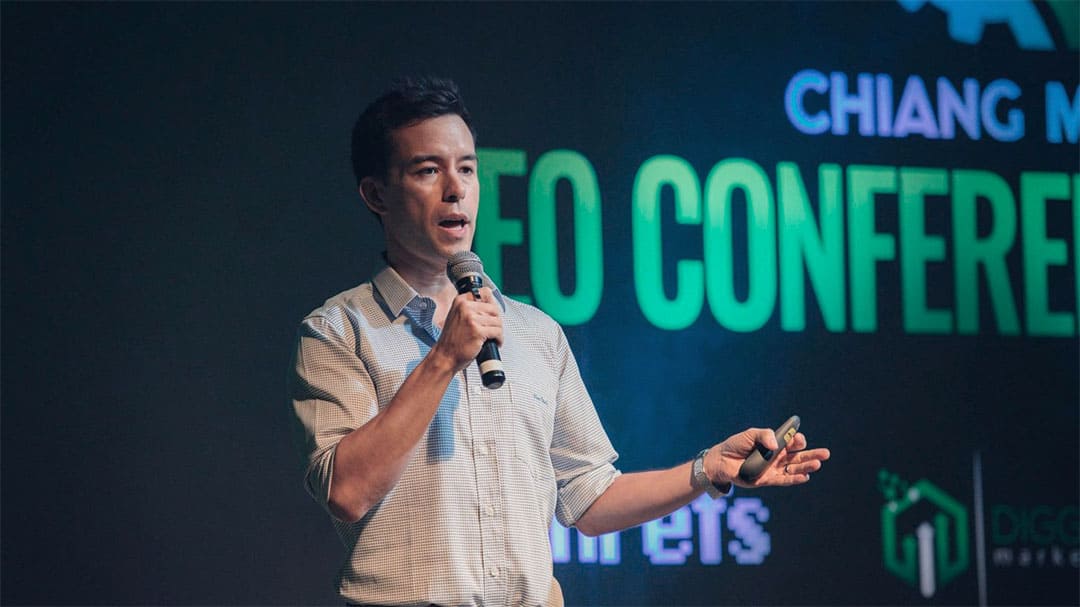
Five days of SEO, digital marketing insights, and networking opportunities
The Chiang Mai SEO Conference brings together leading digital marketers, affiliate entrepreneurs, and SEO professionals from around the world. Usually hosted at a major hotel in Chang Klan it offers a packed agenda of keynote speeches, panel discussions, and hands-on workshops. Chiang Mai’s vibrant digital nomad community makes it a hotspot for industry professionals to connect and learn the latest trends in SEO and online marketing.
Highlights:
- Where: Big hotel near the Night Bazaar
- Weather: November offers cool, dry weather—perfect for enjoying the event and exploring the city
- Planning Tip: Tickets typically sell out as soon as they are released so plan well in advance to secure your spot.
- Pro Tip: Stay extra days to enjoy Loy Krathong, held just before the event
- Official Site: Chiang Mai SEO Conference
10. Chiang Mai Design Week (December 7-15, 2024)
A week celebrating creativity and innovation in art and design
Chiang Mai Design Week showcases the creative talents of local and international designers, with exhibitions, workshops, and installations spread across the city. From interactive art to sustainable product design, this event highlights the city’s reputation as a hub for creative industries.
Highlights:
- Where: Throughout the Old City and Nimmanhaemin areas
- Weather: Pleasant, cool weather typical of early December
- Planning Tip: Join guided tours of the exhibitions for deeper insights
- Pro Tip: Visit pop-up markets for unique souvenirs and design pieces
Official Site: Chiang Mai Design Week
11. TEDxChiangMai (2025 Dates TBA)
Inspiring talks and thought-provoking ideas from local and international speakers
TEDxChiangMai is part of the globally renowned TEDx series, with a focus on innovation, sustainability, and creative solutions relevant to Northern Thailand. The event features a mix of talks, performances, and networking opportunities, attracting a diverse audience from entrepreneurs and students to digital nomads and expats. Talks span topics from technology and education to social impact and art, emphasizing local solutions with a global impact.
Highlights:
- Where: Often held at the Northern Science Park (check official site for updates)
- Weather: If held in early winter, expect cool, dry weather—perfect for mingling outdoors
- Planning Tip: Purchase tickets early, as the event often sells out quickly
- Pro Tip: Stay after the talks to join networking events and connect with other attendees
- Official Site: TEDxChiangMai
12. Block Mountain (2025 Dates TBA)
Chiang Mai’s premier blockchain conference for enthusiasts and professionals alike
Block Mountain is Northern Thailand’s leading blockchain conference, attracting crypto enthusiasts, developers, and entrepreneurs. While much of the programming is in Thai, international participants are welcome to join. The event aims to “spark the future” with discussions on cryptocurrency trends, immersive tech, and decentralized finance.
Highlights:
- Where: Northern Science Park & Nimman area
- Weather: Cool, dry weather in January—perfect for day and evening events
- Planning Tip: Purchase a multi-day pass to gain access to all sessions and networking events
- Pro Tip: Don’t miss the lively welcome party
- Official Site: Block Mountain
When to Visit Based on Your Travel Style
The best time to visit Chiang Mai depends on your priorities and travel style. Here’s a breakdown for different types of visitors:
For Tourists
- Cool Season (November-February): Ideal for perfect weather and festive atmosphere. Expect higher prices and crowds.
- Hot Season (March-May): Lower prices and fewer tourists, but be prepared for intense heat and potential air quality issues.
- Rainy Season (June-October): Budget-friendly with lush scenery, but occasional rain may disrupt outdoor plans.
For Digital Nomads
- Cool Season: Great for networking and events, but higher living costs.
- Hot Season: Consider a temporary relocation during peak burning season (February-April).
- Rainy Season: Ideal for productivity with cheaper rent and a cozy atmosphere.
For Long-term Expats
- Aim to experience a full year to appreciate Chiang Mai’s seasonal rhythms.
- Choose housing with good air conditioning and avoid flood-prone areas.
- Plan your annual getaways during burning season if you can.
Remember, there’s no universally “best” time to be in Chiang Mai. The ideal season depends on your priorities, budget, and tolerance for various weather conditions.
Beyond Chiang Mai: Multi-Destination Itineraries
Want to optimize your time in Thailand and Southeast Asia? Here are three itineraries that combine the best of Chiang Mai with other amazing destinations nearby, optimized for seasonal weather and events. The different monsoon patterns mean you can enjoy great beach weather in Southeast Asia almost year-round – but you have to choose your coast wisely.
Chiang Mai to Andaman Beaches
Best Time: November to early February
Destinations: Bangkok (3-5 days) → Chiang Mai (2-3 weeks) → Phuket or Krabi (1-2 weeks)
Get acclimated with a couple days in Bangkok, then come up to enjoy Chiang Mai at its best during the cool season. Loy Krathong is amazing in Bangkok or Chiang Mai, but Yi Peng’s epic lantern release is unique to Northern Thailand. Afterwards, head to the beach in Phuket or Krabi, which are at their best during this period. This itinerary takes advantage of the dry season on Thailand’s Andaman coast for guaranteed sunny beach days and island excursions.
Chiang Mai to Gulf Coast of Thailand
Best Time: February to April
Destinations: Chiang Mai (2-3 weeks) → Bangkok (3-5 days) → Koh Samui or Koh Phangan (1-2 weeks)
Begin your journey in Chiang Mai and enjoy fewer crowds, and lower prices during this shoulder season. If you start in February you catch the tail end of the cool season, or start in April to jump into the riot of Songkran celebrations.
It’s hot AF this time of year, so it makes sense to spend most of your trip in air-conditioning or at the beach. Bangkok makes for a natural stopover, as direct flights from Chiang Mai to the gulf islands can be pricey. Spend a few days exploring the capital before heading to the beach: Koh Samui, Koh Phangan & Koh Tao can be enjoyed individually or together. This route is ideal as the Andaman coast starts getting rainier, while the Gulf of Thailand stays relatively dry.
Southeast Asia Trifecta: Culture, City, and Beach
Best Time: November to April
Destinations: Chiang Mai (2-6 weeks) → Ho Chi Minh City (2-6 weeks) → Bali (2-6 weeks)
Start your journey in Chiang Mai during the cool, dry months. Immerse yourself in the local culture and digital nomad scene. As hot season approaches, jet off to Ho Chi Minh City for a dose of vibrant urban life and fascinating history. Finally, land in Bali as its dry season begins, perfect for beach hopping and spiritual retreats.
Pro tip: This itinerary is ideal for digital nomads who can enjoy longer stays in each hotspot
In Conclusion, Chiang Mai is Always Great
As a longtime resident and incorrigible hometown hype-girl, I’m tempted to dismiss the very question “when is the best time to visit Chiang Mai?” I love this city and enjoy it year-round. I find even the worst parts are worth embracing because they’re a lesson in contrasts or an invitation to travel elsewhere.
But of course, if you’re planning a once in a lifetime trip, you’ll want to optimize. I hope we’ve covered enough information in this comprehensive guide to Chiang Mai’s weather and top events to help you do that.
Each season in Chiang Mai brings its own blessings. The cool season’s festivals and perfect weather, the hot season’s quieter streets and mango abundance, the rainy season’s lush beauty and cozy atmosphere – I like to think there’s something for everyone every time of year.
Yes, there are challenges. The burning season is a real issue that the city is grappling with. The tourist crowds in high season can be overwhelming. The heat can be intense, and the rain occasionally turns into flooding. But for many of us who call Chiang Mai home, we’d still choose to be here any time of year.
